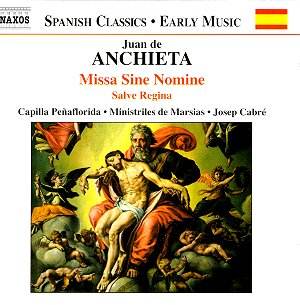Related to Ignatius
Loyola, Juan de Anchieta was born in
1462 and spent much of his life in royal
service. In 1489 he was appointed as
a singer in Queen Isabella’s court,
gradually rising in importance over
the years, accompanying the royal court
as far afield as Brussels and England.
He remained with Queen Joanna, Isabella’s
heir, after her abdication but suffered
an attack by two of the Loyola brothers
and was lucky to have emerged unscathed
through the political and religious
complexities of the time (a nephew who
succeeded Anchieta as Abbot of Arbás
was not so lucky and was murdered).
He retired in 1519 but was allowed to
retain his salary and after his death
an unseemly squabble took place over
his final resting place.
About thirty or so
works by Anchieta are known to have
survived including two Masses, four
Passion settings, Magnificats and a
Salve Regina. This Missa Sine Nomine
is also known as the Missa quarti toni
and is presented here in its liturgical
and ceremonial context. So The Kyrie
I is an organ elaboration of Josquin’s
music by the royal chapel organist Francisco
Fernandez Palero (d 1597) and Anchieta’s
famous rival and superior Francisco
de Peñalosa is represented by
his Sancta mater istud agas (for instrumental
forces). The Hymn; Pange lingua is in
the setting by Juan de Urreda (conjecturally
born the Flemish Johannes Wreede of
Bruges).
The aim to present
a reconstructed ceremony has been well
met with the interspersed works evoking
a genuine consonance. Anchieta was not
alone in setting L’homme armé,
that pan-European melody of melodies,
but it’s interesting that the use to
which he puts it (in the tenor part
of the Agnus Dei) is relatively restrained
and certainly not straining for technical
dazzle. Elsewhere in the Mass he makes
considerable use of a dotted three-note
figure and he aims for a wholeness of
expression. The opening instrumental
fanfares are bold and affirmatory whilst
the beautiful Introit is excellently
sustained in the attractive ambience
of Villabuena. Some of the Mass does
sound Northern European – Anchieta was
clearly familiar with Josquin for example
– and the way in which Gregorian Chant
is juxtaposed with polyphony is often
seamless – the Agnus Dei is a particularly
impressive example of his sheer technical
skill in this regard. The Mass is not
florid and the nearest it comes to austerity
is the Graduale whilst the Credo moves
with flexibility to a brass punctured
and rather wonderful climax. The simplicity
of Anchieta’s writing can be gauged
from the Ave Sanctissima Maria and the
play of the voices in the Sanctus-Benedictus
is irresistible.
For one who has lain
so long in Peñalosa’s shadow
this Mass shows the sophisticated heights
to which Anchieta could ascend, whilst
never shedding the generous simplicity
of style for which he is know (and often
found wanting). The brass and vocal
forces respond with genuine understanding
and unflagging enthusiasm. Let’s have
more Anchieta from these forces.
Jonathan Woolf


